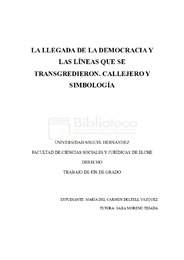Resumen :
Tras el triunfo de los sublevados, una de las tareas que llevaron a cabo fue la abolición de todo lo que había configurado la experiencia republicana del siglo XX. La vía urbana se convirtió en un instrumento que les valió para construir la legitimidad de la dictadura, incluyendo en el callejero nombres de batallas y de personajes relevantes de aquel Nuevo Estado. Así, con la democracia en ciernes de finales de los setenta, se comenzó a revertir la situación: nombres estrechamente vinculados a la sublevación, la guerra civil y la dictadura fueron, poco a poco, abandonando el espacio público para pasar a formar parte del histórico de las ciudades. Ello, sin ningún tipo de norma que amparara tales cambios: ni estatal, ni autonómica, ni local. A través de esta investigación pretendemos arrojar luz sobre la realidad de la ciudad de Alicante, atravesando las causas que los motivaron y cómo se procedió con los mismos, proponiendo una ordenanza que, de haber existido durante la readecuación del callejero, habría facilitado en gran medida tal situación. Como pondremos de manifiesto, con la promulgación de las leyes memoriales apareció el imperativo legal de readecuar numerosos espacios que, hoy en día, podemos seguir cuestionando. Planteamos la revisión de, lo que, a nuestro juicio, continúan siendo vestigios de la dictadura.
After the triumph of the rebels, one of the tasks they carried out was to abolish everything that had shaped the republican experience of the 20th century. The urban road became an instrument that helped them to build the legitimacy of the dictatorship, including in the street map the names of battles and important figures of the New State. At the end of the 1970s, the situation began to be reversed: names closely linked to the uprising, the civil war and the dictatorship began to leave the public space to become part of the history of cities. This, without any kind of regulation to protect such changes: neither state, nor autonomous, nor local. Through this research we intend to shed light on the reality of the city of Alicante, going through the causes that motivated them and how they were carried out, proposing an ordinance that, if it had existed during the readjustment of the street map, would have greatly facilitated such a situation. As we will show, with the enactment of the memorial laws, the legal imperative appeared to readjust numerous spaces which, today, we can still question, so we propose the revision of what, in our opinion, continue to be vestiges of the dictatorship.
|
 La licencia se describe como: Atribución-NonComercial-NoDerivada 4.0 Internacional.
La licencia se describe como: Atribución-NonComercial-NoDerivada 4.0 Internacional.
.png)
